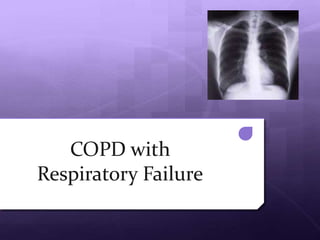
COPD with Respiratory Failure
- 2. Patient Background Daishi Hayato Age 65 Male Asian American Retired Wife and 4 adult children Father had lung cancer Primary Diagnosis: Acute respiratory distress, COPD, peripheral vascular disease with intermittent claudication
- 3. Etiology Acute Respiratory Distress (ARDS) Occurs when fluid builds up in the alveoli in the lungs More fluid in the lungs means less oxygen can reach your bloodstream, depriving organs of the oxygen they need to function Primary symptom: Severe shortness of breath
- 4. Etiology COPD – Chronic Obstructive Pulmonary Disease A progressive disease in which airflow is limited or restricted Most times associated with emphysema (destruction of alveoli/lungs over time), bronchitis (inflammation of the lining of the bronchial tubes), or in rare cases, a genetic protein deficiency Primary risk factor: Smoking Mr. Hayato was diagnosed with emphysema more than 10 years ago and has a long-standing history of COPD secondary to chronic tobacco use of 2 packs per day for 50 years
- 5. Etiology
- 6. Etiology Peripheral vascular disease with intermittent claudication Peripheral vascular disease occurs when the arteries in the extremities become clogged with a fatty substance called plaque This plaque build up causes atherosclerosis in the arteries, obstructing blood flow The blocked arteries cause claudication or “crampy leg” when exercising, with pain that comes and goes
- 7. Nutrition History Appetite: Fair but BMI: 21.7 kg/m2 decreasing %UBW: 90% Largest meal: Breakfast IBW: 126 lbs Highest Weight: 135 lbs %IBW: 97% Current Weight: 122 lbs Unintended Weight Loss Height: 5’4” Estimated REE needs: No previous nutrition 1500 – 1600 kcals therapy 80 - 83 grams protein
- 8. At the Hospital Chest tube inserted into left thorax with drainage under suction Endotracheal intubation Placed on ventilation 15 breaths/min with an FiO2 of 100% Positive end-expiratory pressure of 6 Tidal volume of 700 mL Daily chest radiographs (X-ray) and ABGs each A.M.
- 9. Treatment Plan ABG, pulse oximetry, CBC, chemistry panel, UA (urinalysis) Chest X-ray, ECG, Proventil IVF D5 ½ NS at TKO Spirogram post nebulizer tx NPO Increased calorie needs (10-15%)
- 10. Tube Feedings Initiated on Day 2 of admission Isosource @ 25 cc/hr continuously over 24 hours Receiving 720 calories and 25.8 grams of protein per day High gastric residuals led to discontinued use of enteral feeding and initiation of peripheral parenteral nutrition (PPN) PPN @ 100 cc/hr ProcalAmine – 3% glycerin, 3% amino acids Receiving 312 calories and 69.6 grams of protein per day Regular IV at D5 ½ NS at TKO was discontinued
- 11. Tube Feedings Day 4: Enteral feeds restarted @ 25 cc/hr, increased to 50 cc/hr after 12 hours ProcalAmine also continued @ 100 cc/hr Total Energy Intake: 1,712 calories – excessive Respiratory status became worse on Day 5; ProcalAmine was discontinued Enteral feedings continued until Day 8 Patient weaned from ventilator Day 8 Discharged on Day 11
- 12. Lab Values: Arterial Blood Gases (ABGs) 70 65 66 60 60 56 57 50 50 pH 40 pCO2 35 36 30 29 CO2 pO2 20 HCO3 10 7.2 7.36 7.22 0 Day 1 Day 3 Day 5
- 13. Medical Nutrition Therapy: Nutrition Diagnosis Excessive intake from enteral/parenteral nutrition related to excessive energy intake as evidenced by elevated CO2 levels and an increased RQ
- 14. Medical Nutrition Therapy: Intervention Initiate EN or PN (ND-2.1) Modify rate, concentration, composition, or schedule (ND-2.2) Discontinue EN or PN (ND-2.3) Priority modification (E-1.2) Goal setting (C-2.2) Social support (C-2.5)
- 15. Medical Nutrition Therapy: Monitor & Evaluation Monitor enteral feeding tolerance (residuals) & peripheral parenteral nutrition Monitor lab values Arterial blood gases (ABGs) pH Blood counts RQ Monitor weight gain/loss
- 16. Medical Nutrition Therapy: D/C Treatment for Mr. Hayato Prevent further weight loss by eating sufficient calories Consume a diet rich in antioxidants fruits, vegetables, and fish helps lower incidence of COPD Decrease consumption of red meats, refined grains, desserts and french fries Increased consumption of vitamins C, A, and E and beta- carotene to help cope with oxidative damage undergone during exacerbation which depletes concentrations of these vitamins Monitor phosphate levels for adequacy; crucial for pulmonary function because it is essential for synthesis of ATP
- 17. Medical Nutrition Therapy: D/C Treatment for Mr. Hayato Assess calcium and vitamin D intake and ensure adequacy to help prevent osteoporosis Advise patient to consume good sources of protein and calories, as well as sources that are nutrient dense Rest before meals to avoid fatigue Eat smaller, more frequent meals to alleviate feelings of fullness and bloating Advise exercise, as capable Strength/resistance training may help improve skeletal muscle function; skeletal muscle dysfunction is often an indicator of COPD in its advanced stages
- 18. Prognosis There is no cure for COPD Ways to Improve Overall Quality of Life: Smoking Cessation Dietary changes Taking medications as directed Routine medical care and as needed
- 19. Question #1 Why are high gastric residuals in tube-fed patients dangerous?
- 20. Question #2 What primary macronutrient makes it more difficult to wean a patient from a ventilator? Why?
- 21. Question #3 What two factors indicated that Mr. Hayato was receiving excess nutrition from his parenteral and enteral feeds?
- 22. References http://www.mayoclinic.com/health/ards/DS00944 http://www.emphysemafoundation.org/pulmonary-disease/57-copd.html http://www.rxlist.com/procalamine-side-effects-drug-center.htm http://www.todaysdietitian.com/newarchives/060210p8.shtml http://www.in.gov/fssa/files/aspiration_prevention_8.pdf. Medeiros, D., Wildman, R. (2009). “Advanced human nutrition.” Sudbury, MA: Joans and Bartlett Learning, LLC. Nelms, M., Sucher, K. (2011). “Nutrition therapy and pathophysiology.” Belmont, CA: Wadsworth Cengage Learning. http://www.umm.edu/patiented/articlesintermittent_claudication_other_symptoms_of_peripheral_artery_disease_000102 http://dailymed.nlm.nih.gov/dailymed/drugInfo.cfm?id=66097 http://www.drugs.com/pro/procalamine.html